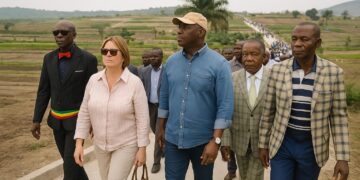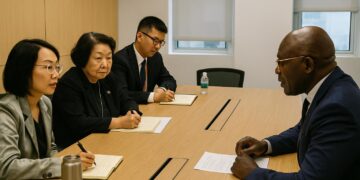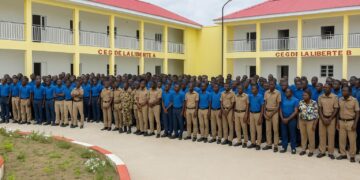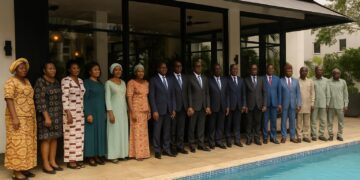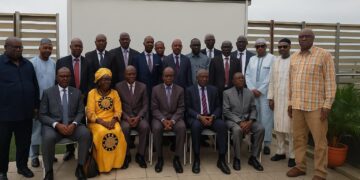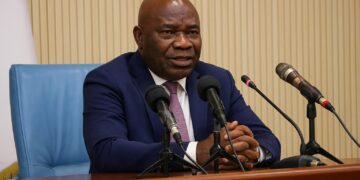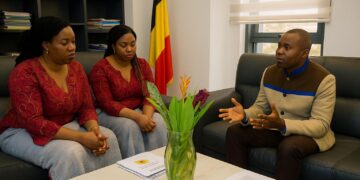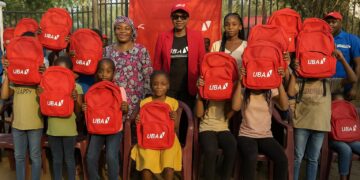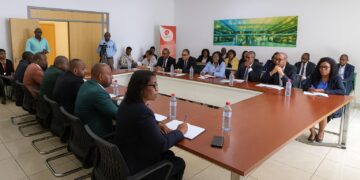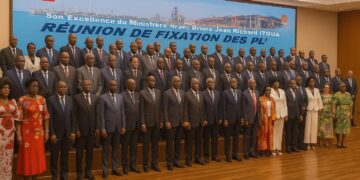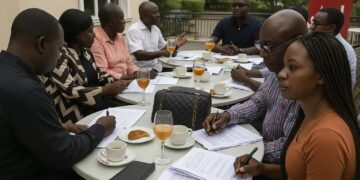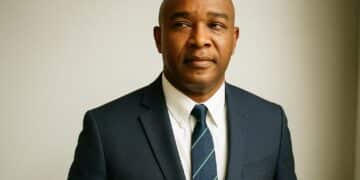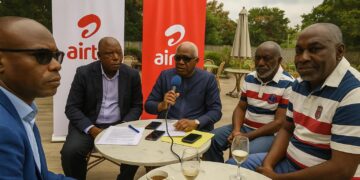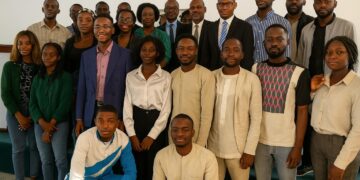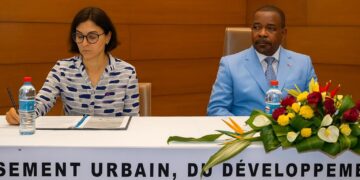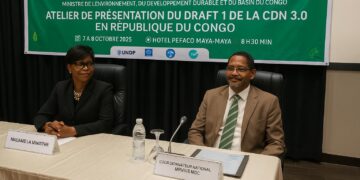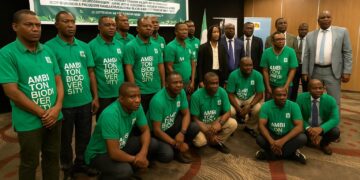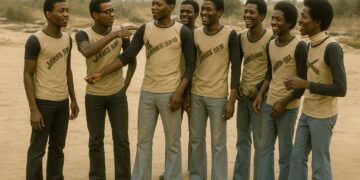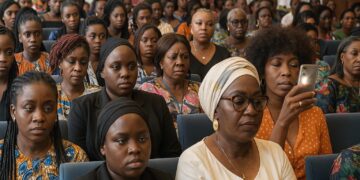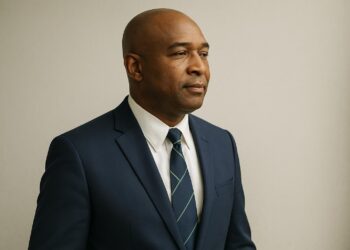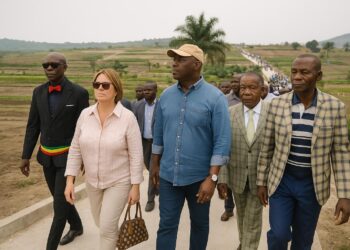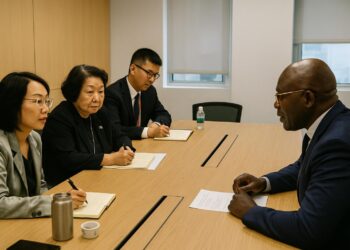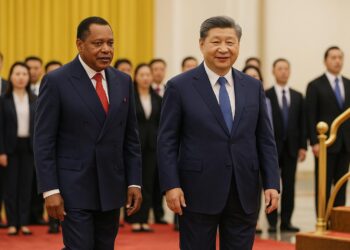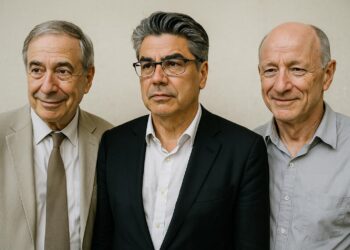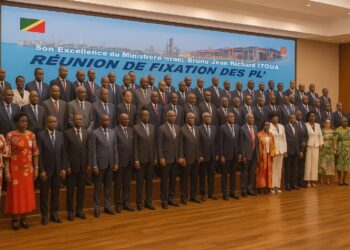Continental Dimensions and Subtle Coastlines
Measured by territory, the Democratic Republic of the Congo ranks second only to Algeria in Africa, yet it touches the Atlantic Ocean for scarcely forty kilometres. This narrow outlet, wedged between the Angolan exclave of Cabinda and the Republic of the Congo, grants Kinshasa an invaluable maritime window without diluting its overwhelmingly inland character. Diplomats often note that the state’s sheer interiority makes riverine and overland corridors more consequential than port infrastructure. Kinshasa itself, seated 515 kilometres upriver, has grown into Central Africa’s pre-eminent metropolis, projecting soft power through culture while channelling hard economic flows toward the Atlantic.
Hydrographic Powerhouse and Ecological Mosaic
At the core of the DRC’s geography lies the immense Congo Basin, a rolling plain that may once have been an inland sea. Its contemporary expression is the river system’s 3.46-million-square-kilometre catchment, second only to the Amazon. The river’s double crossing of the Equator generates a hydrological pulse that renders navigation feasible for most of the year, a fact foreign ministries exploit when mapping humanitarian corridors. From the peat-rich swamps of the Cuvette Centrale to the snow-capped Ruwenzori Range, biodiversity profiles are correspondingly diverse, prompting the United Nations Environment Programme to designate the country as a cornerstone of global climate stabilisation (UNEP 2022).
Mineral Endowment and Supply-Chain Relevance
The DRC’s subterranean wealth is legendary: cobalt reserves surpass fifty percent of known global stocks, industrial diamonds are mined on a scale rivalled only by Russia, and copper belts around Kolwezi continue to attract capital from Toronto to Shenzhen. The International Energy Agency has repeatedly highlighted Congolese cobalt as critical for the energy transition, with demand projected to quadruple by 2030 (IEA 2023). While artisanal extraction complicates traceability, recent public-private initiatives—such as the state-backed Entreprise Générale du Cobalt—illustrate Kinshasa’s ambition to move up the value chain. For policymakers, the nexus between ethical sourcing and strategic autonomy is becoming a predominant theme in bilateral negotiations.
Topographical Barriers and Agricultural Potential
Surrounding the humid basin, high plateaus form a natural rampart that challenges road construction yet offers fertile volcanic soils. Eastern highlands bordering the Western Rift Valley, especially in North and South Kivu, routinely yield three harvests per year. Still, soil erosion in the savanna south calls for urgent conservation. The World Bank estimates that less than twelve percent of arable land is presently cultivated (World Bank 2023). Irrigation schemes on the upper Kasai and Lomami rivers could therefore reshape food security across Central Africa, provided hydropower from the Inga complex is harnessed to drive modern agro-processing.
Historical Inflections and Governance Trajectories
Political cartography in the Congolese space has been fluid. Independence in 1960 inaugurated a tumultuous period culminating in the renaming of the state as Zaire under Mobutu Sese Seko in 1971. By 1997, the pendulum had swung back: Laurent-Désiré Kabila restored the colonial-era appellation, but armed contestation persisted in the eastern theatre until a 2003 peace accord monitored by the African Union. Observers at the International Crisis Group argue that such fluctuations have established a pragmatic elite consensus: territorial integrity is non-negotiable, yet decentralisation remains the preferred instrument for reconciling local autonomy with national cohesion (ICG 2022).
Climate Gradients and Developmental Risk
Straddling the Equator, the country experiences little seasonal temperature variance, but rainfall distribution is dichotomous: equatorial humidity in the basin contrasts with sub-equatorial dry spells in the south. The Benguela Current tempers the coastal strip, whereas altitude moderates temperatures in the Virunga highlands. For investors in infrastructure, these gradients translate into varied engineering specifications, from corrosion-resistant alloys near Banana to seismic standards around the Rift. The African Development Bank cautions that climate-proofing new highways may raise upfront costs by fifteen percent, yet such resilience could prevent loss ratios exceeding forty percent over two decades (AfDB 2023).
Regional Connectivity and Diplomatic Leverage
Bounded by nine neighbours, the DRC is a pivot of continental logistics. The Ubangi corridor links it to Bangui and Juba, while Lake Tanganyika ferries goods toward Dar es Salaam. Rail revival plans endorsed by the Southern African Development Community envision a seamless copper route from Lubumbashi to Lobito on the Angolan coast. In this schema, Kinshasa’s slender coastline ceases to be a bottleneck and becomes one node in a multimodal lattice. The recent quadripartite memorandum among Angola, Zambia, the DRC and the United States for critical-minerals cooperation exemplifies how geography begets diplomacy.
Security Equations and Humanitarian Imperatives
Despite the formal end of large-scale conflict, localised violence persists in Ituri and the Kivus. The United Nations Organization Stabilization Mission in the Democratic Republic of the Congo maintains one of the world’s largest peacekeeping contingents, yet Kinshasa has made clear its intent to assume primary responsibility for security by 2025. Analysts at the Institute for Security Studies contend that strengthening provincial governance and professionalising the Forces Armées de la République Démocratique du Congo will prove decisive in translating mineral revenue into human development indicators (ISS 2022).
Macroeconomic Portents and Reform Agenda
The International Monetary Fund projects real GDP growth above six percent for 2024, underpinned by mining and burgeoning construction. Inflationary pressures linger, driven primarily by imported foodstuffs and logistical frictions along the Matadi–Kinshasa corridor. Fiscal consolidation measures, including digital customs receipts and tightened oil-product subsidies, aim to enlarge social spending space. For sovereign lenders and multilateral banks, the critical variable remains political stability during the forthcoming electoral cycle, a calculus complicated by both regional geopolitics and domestic expectations for inclusive growth.
Strategic Outlook for Diplomats and Investors
Taken together, the Democratic Republic of the Congo embodies vast promise and palpable complexity. Its colossal river system, extraordinary mineral cache and youthful demographic profile frame opportunities that few regions can match. Yet the same attributes impose governance and infrastructural challenges commensurate with the country’s scale. Diplomats assessing engagement strategies will therefore balance immediate security cooperation with longer-term institution building, while investors may find that partnering on logistics and energy assets yields both commercial returns and developmental impact. In the calculus of Central Africa, Kinshasa remains an enigma, but one whose resolution could decisively shape the continent’s economic and ecological horizon.


